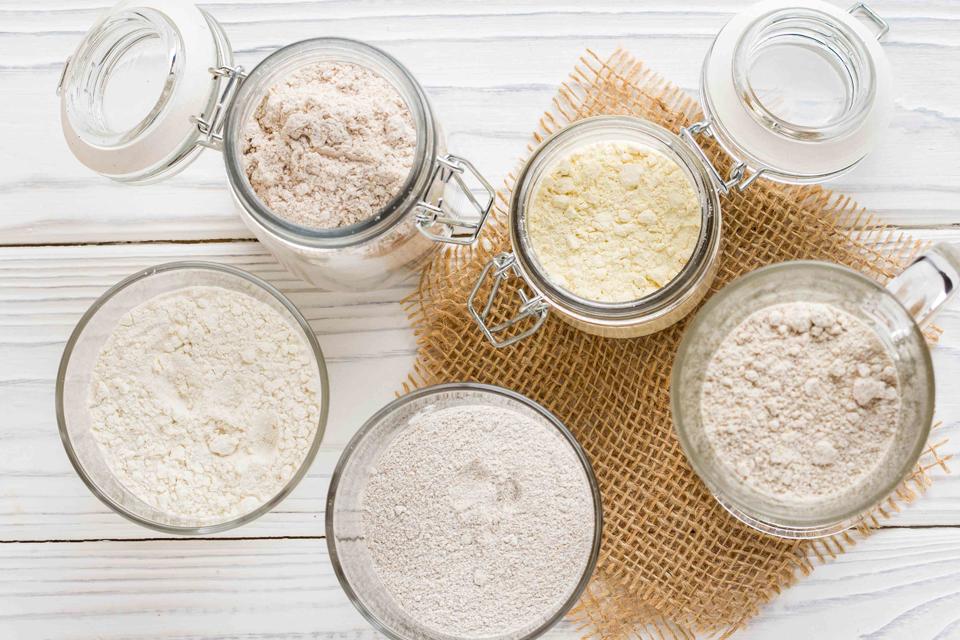The Right Way to Store Every Type of Flour
Learn how to keep white, whole-wheat, and alternative flours fresh and accessible for whenever the baking urge hits.

Maria_Lapina / Getty Images
Whether you stir up a batch of plump blueberry muffins every weekend or occasionally treat your family to a homemade deep-dish pizza, chances are you keep a supply of different flours on hand. To ensure that each one is at its best whenever cravings hit, you should know how to store flour properly. After all, flour—whether all-purpose, whole-wheat, or quinoa flour—has a shelf life. If not stored correctly, flour can pick up unpleasant flavors and aromas or become infested with bugs. We connected with baking experts to learn more about the right storage methods and got their tips for storing all types of conventional and alternative flours.
Meet Our Expert
Dan Langan, professional pastry instructor and author of Bake Your Heart Out: Foolproof Recipes to Level Up Your Home Baking
Frank Tegethoff, research and development specialist, King Arthur Baking Company
Related: 5 Most Common Types of Flour—and How to Sub One for Another
How to Store Flour
For many home bakers, there's no debate about where to store flour: The default landing spot is the pantry or kitchen cupboard. But it turns out that a convenient cupboard might not be the perfect perch for all the flours in your collection.
Pantry or Freezer?
Flour should be stored in a cool, dry place and a tightly sealed container says Frank Tegethoff, research and development specialist at King Arthur Baking Company. Nut, garbanzo, quinoa, and other specialty flours particularly benefit from those conditions, says Dan Langan, professional pastry instructor and author of Bake Your Heart Out. But which flours should be stored where?
Store in the Pantry
White flour: White flour and degerminated grains, like cornmeal, are fine in the pantry, says Tegethoff.
Store in the Freezer
Whole-grain flours: Whole-grain flours are better stored in the freezer to protect the volatile oils contained in the germ, says Tegethoff.
Nut and gluten-free flours: The freezer is optimal for nut flours, garbanzo flour, and other gluten-free flours and can be utilized across the board, says Langan. "All flours can be stored in the freezer for longer-term storage," he says.
"When in doubt, place the bag of flour into a resealable freezer bag and store in the freezer for extended storage," says Langan. The freezer is also a consideration if your kitchen gets hot in the summertime, he says.
Tips
Forgo the Fridge
While the freezer can be flour-central, the fridge should not be your go-to storage spot. "Personally, I'm not a fan of keeping flour under refrigeration—the environment is usually far too high in humidity, and the opportunity for introducing even more moisture due to condensation while measuring makes this a less than ideal storage space," says Tegethoff.
Related: Everything You Need to Know About Flour, From All-Purpose to Whole-Wheat
Decanting Flours
Decanting isn't always a given; sometimes, it's a matter of personal preference. Here's how the experts approach this storage step:
Handy canisters: "I typically decant flour into sealed food storage containers or keep the flour in its packing place inside a resealable plastic bag," says Langan. If he's leaving flour in the latter, he squeezes the excess air out of the bag before sealing.
Durable containers: If you reach for flour often, Langan suggests storing it in a container that will stand up to constant use. Food-safe plastic or glass containers with tight-fitting lids keep moisture and pests out.
When to skip decanting: Tegethoff notes that the need to decant may also depend on the product's original packaging. "Paper bags are designed for transport, not long-term storage," he says. Once the paper bag is opened, the flour should be transferred to a sealable container. "Flours arriving in resealable plastic pouches may be confidently left as they are."
Related: 5 Most Common Types of Flour—and How to Sub One for Another
How Long Flour Lasts
Like many basics on your shopping list, flour comes stamped with a best-by date, which should be observed for peak performance. "Flour is a natural product and contains some moisture and oil, which makes it prone to spoilage," says Langan. He advises buying smaller amounts of alternative flours that you might use less often rather than bulk.
White flour endures: Generally, you can expect all-purpose flour to last up to one year after purchase. That said, it can sometimes have even greater lasting power. When stowed in the right environs, white flours and starches have an almost indefinite shelf life, says Tegethoff. "However, they can become infested or otherwise contaminated (aromas, flavors, etc.) if not properly stored," he cautions.
Whole-grain is perishable: Whole-grain flours are much more susceptible to degradation due to the volatile oils in the germ of the grain, says Tegethoff. Their shelf life is about six to 12 months. Even with a best-by date, improper storage once in the home can significantly diminish the product's longevity, he says. "I always give whole-grain flours a quick sniff test to make sure I don’t smell any oxidized oils (if they are present, the flour will smell like Play-Doh)."
Read the original article on Martha Stewart.

